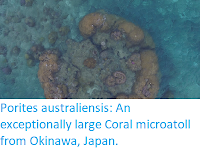The loss of coastal habitats has become a considerable concern in recent years, with numerous studies showing declines in habitats such as salt marshes, Mangroves, Kelp forests, shellfish beds and Coral reefs. However, while these ecosystems have been extensively monitored since people became concerned about them in the late twentieth century, determining longer-term changes in coverage is much more difficult. Changes in coastal environment in the twentieth century for some areas have been determined from aerial photographs, and longer term changes in shellfish beds have been determined for some temperate areas using charts made for economic reasons, and drill-core samples can tell us about changes to Coral cover at specific points, though clearly such drill-cores are themselves destructive to obtain, preventing extensive use of this method.
In a paper published in the journal Science Advances on 6 September 2017, Loren McClenachan of the Environmental Studies Program at Colby College, Grace O’Connor of Columbia University, Benjamin Neal of the Bigelow Laboratory for Ocean Sciences, John Pandolfi of the School of Biological Sciences at the University of Queensland, and Jeremy Jackson of the Department of Paleobiology at the National Museum of Natural History, and the Center for Marine Biodiversity and Conservation at the University of California, San Diego, describe the results of a study which used eighteenth century Royal Navy charts to determine changes in Coral cover in the Florida Keys.
During the eighteenth century the Royal Navy carried out extensive mapping of coastal areas around imperial possessions and other areas of interest, dispatching scientists such as Joseph Banks to aid with the creation of the first high resolution data sets for coastal waters, by including large amounts of ecological and geological information that is missing from later nautical charts. McLenachan et al. were able to obtain two maps of the Florida Keys area in the 1770s from the Admiralty Library and Archive of the UK Hydrographic Office, which together recorded 143 historical Coral observations.
Using these charts, McLenachan et al. divided the area into five zones; (1) the inshore waters of Florida Bay, (2) nearshore patch reefs, (3) offshore patch reefs, (4) the reef crest and (5) the forereef.
Historical Coral map and zones of the Lower Keys area, modified from Gauld (1774). McLenachan et al. (2017).
McLenachan et al. found that Corals had declined by 87.5% in Florida Bay, 68.8% on the nearshore patch reefs, 40.0% on the offshore patch reefs, 12.1% on the reef crest and not at all on the forereef. This fits well with expectations based upon historical data, with the construction of a railway between 1906 and 1914 having led to large-scale drainage and land conversion in the Everglades, resulting in a decline in freshwater input combined with an accumulation of oxidised organic carbon products in the bay, a change in environment known to have provoked a wholesale decline in nearshore Corals, with monitoring in the bay abandoned in 2001 due to the paucity of Coral there.
Example of nearshore coral loss near Key West, Florida. (A) Excerpt of Guald’s 1774 nautical chart, with locations of coral indicated with black rectangles. The inset shows an enlarged image of two adjacent historical coral references. (B) Same area today, represented by Google Earth imagery overlaid on the compiled modern benthic habitat map. Black rectangles indicate areas of coral persistence; gray rectangles indicate coral loss. McLenachan et al. (2017).
This methodology appears to provide good information on Coral coverage, in so far as the charts were careful to distinguish between Coral and rock, it does not provide reliable details on the distribution of individual Corals; for example where Gould records 'Brown Coral banks' in 1-2 m of water, this is probably Acropora palmata, but there is no way of actually knowing this, so it is impossible to tell if the areas covered by Coral in the 1770s and today are in fact covered by the same species. Nevertheless McLenachan et al. believe that this method could potentially be used in other areas, such as Jamaica or Hong Kong.
See also...
Follow Sciency Thoughts on Facebook.







